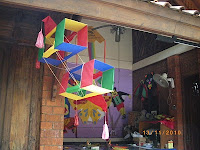Malam itu ketika aku sedang tidur ada petir sangat keras menyambar dan membuat alarm mobilku berbunyi dan membuat listrik dirumah ku mati. Besoknya adalah hari sabtu dan ternyata listrik di rumah masih mati. Itu adalah hari yang menyedihkan. Lalu kami memutuskan untuk pergi jalan jalan. Mana tahan tinggal dirumah waktu tidak ada listrik. Lalu tanpa sengaja mommy ingat Museum Layang - Layang lalu kami bersiap dan pergi ke Museum Layang - Layang. Aku sudah tidak sabar lagi untuk cepat - cepat sampai. Katanya, disana bukan hanya layang - layang saja ada juga cara membuat keramik, membuat batik dan disana bisa membikin layang - layang sendiri. Ternyata jauh dan macet. Akhirnya kami sampai di Museum Layang - Layang. Kami memilih untuk membuat layang daripada membuat keramik atau membuat batik. Disana kami nonton dulu tentang sejarah layang - layang. Lalu kami melihat - lihat koleksi layang - layang yang ada disana. Disana ada banyak layang - layang yang besar dan keren.
Kalau mau tahu tentang semua layang - layang yang ada disana segera saja kunjungi Museum Layang - Layang Indonesia. Wuih ! Keren - keren lho. Lalu disana hujan, yah, tapi gak papa lah.
 |
| Kendaraan untuk menerbangkannya |
 |
| Layang - Layang sport |
Disana aku melihat layang - layang sport yang dinaiki oleh seseorang disebuah kendaraan. Ini ada photoku ketika dipotret menaiki kendaraan layang - layang itu tapi layang layang itu tidak diterbangkan : Lalu kami membuat layang - layang yang aku tunggu - tunggu sejak dari tadi.
 Pertama tama aku lem dulu rangka kayunya.
Pertama tama aku lem dulu rangka kayunya. Lalu aku tempel rangka ke kertas yang akan aku gunting mengikuti garis yang telah ada menjadi layang - layang lalu aku lipat kertas mengikuti benang yang ada pada rangka kayu lalu sisinya aku potong sedikit dan aku warnai layang - layang sesukaku. Lalu diikat benang yang ada yang ada pada layang - layangku pada benang yang lain.
Ini ada photo koleksi layang layang di Museum Layang - Layang :





























